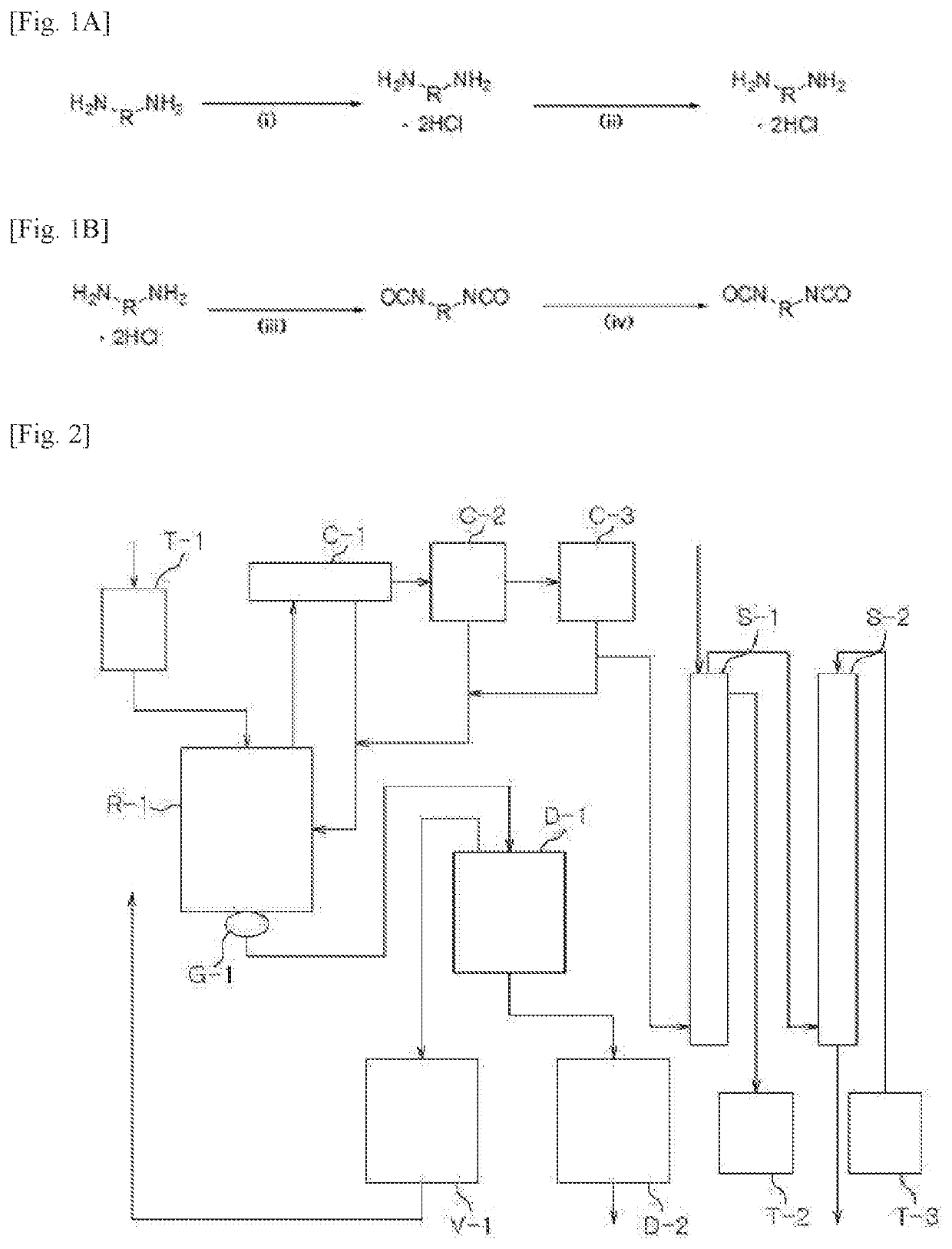Diisocyanate composition, preparation method thereof and optical material using same
- Summary
- Abstract
- Description
- Claims
- Application Information
AI Technical Summary
Benefits of technology
Problems solved by technology
Method used
Image
Examples
examples 1-1 to 1-4
[0267]Step (1): Preparation of a Diamine Hydrochloride Composition
[0268]A reactor was charged with 1,009.4 g (9.46 moles) of an aqueous solution of 35% hydrochloric acid, followed by lowering the internal temperature of the reactor to 15° C. with stirring. While the temperature of the reactor was maintained at 20° C. to 50° C., 600.0 g (4.4 moles) of m-XDA was introduced for 1 hour. Upon completion of the introduction, the internal temperature of the reactor was lowered to 10° C., and it was stirred for 1 hour. Thereafter, 1,320.0 g of tetrahydrofuran (THF) was introduced, and the internal temperature of the reactor was lowered to −5° C., followed by stirring for 1 hour. Upon completion of the reaction, the diamine hydrochloride composition containing m-XDA-2HCl was separated by vacuum filtration using a filter, and the filtered tetrahydrofuran was recovered for reuse. The separated diamine hydrochloride composition was dried under vacuum at 90° C. and 0.5 torr to remove the residua...
example 1-5
[0271]Step (1): Preparation of a Diamine Hydrochloride Composition
[0272]Reactor 1 was charged with 1,009.4 g (9.46 moles) of an aqueous solution of 35% hydrochloric acid, followed by lowering the internal temperature of the reactor to 15° C. with stirring. While the temperature of Reactor 1 was maintained at 50° C. or lower, 627.0 g (4.4 moles) of H6XDA was introduced for 1 hour. Upon completion of the introduction, the internal temperature of Reactor 1 was lowered to 10° C., and it was stirred for 1 hour. The internal temperature of Reactor 2 to which 2,640.0 g of diethyl ether had been charged was lowered to −5° C. The mixture in Reactor 1 was slowly added dropwise to Reactor 2 at 0° C. or lower. Upon completion of the addition, the diamine hydrochloride composition containing H6XDA.2HCl was separated by vacuum filtration using a filter, and the filtered diethyl ether was recovered for reuse. Thereafter, the separated diamine hydrochloride composition was dried under vacuum at 90°...
example 1-6
[0275]Step (1): Preparation of a Diamine Hydrochloride Composition
[0276]A reactor was charged with 1,009.4 g (9.46 moles) of an aqueous solution of 35% hydrochloric acid, followed by lowering the internal temperature of the reactor to 15° C. with stirring. While the temperature of the reactor was maintained at 50° C. or lower, 490.1 g (4.4 moles) of HDA was introduced for 1 hour. Upon completion of the introduction, the internal temperature of the reactor was lowered to 10° C., and it was stirred for 1 hour. Thereafter, 1,320.0 g of tetrahydrofuran was introduced, and the internal temperature of the reactor was lowered to −5° C., followed by stirring for 1 hour. Upon completion of the reaction, the diamine hydrochloride composition containing HDA.2HCl was separated by vacuum filtration using a filter, and the filtered tetrahydrofuran was recovered for reuse. Thereafter, the separated diamine hydrochloride composition was dried under vacuum at 90° C. and 0.5 torr to remove the residu...
PUM
| Property | Measurement | Unit |
|---|---|---|
| Temperature | aaaaa | aaaaa |
| Temperature | aaaaa | aaaaa |
| Temperature | aaaaa | aaaaa |
Abstract
Description
Claims
Application Information
 Login to View More
Login to View More - R&D
- Intellectual Property
- Life Sciences
- Materials
- Tech Scout
- Unparalleled Data Quality
- Higher Quality Content
- 60% Fewer Hallucinations
Browse by: Latest US Patents, China's latest patents, Technical Efficacy Thesaurus, Application Domain, Technology Topic, Popular Technical Reports.
© 2025 PatSnap. All rights reserved.Legal|Privacy policy|Modern Slavery Act Transparency Statement|Sitemap|About US| Contact US: help@patsnap.com



